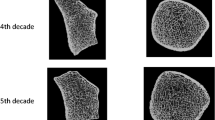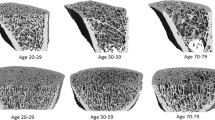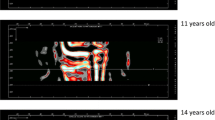Abstract
Using peripheral quantitative computed tomography (pQCT) we assessed trabecular and cortical bone density, mass and geometric distribution at the tibia level in 512 men and 693 women, age range 20–102 years, randomly selected from the population living in the Chianti area, Tuscany, Italy. Total, trabecular and cortical bone density decreased linearly with age (p<0.0001 in both sexes), and the slope of age-associated decline was steeper in women than in men. In men, the cortical bone area was similar in different age groups, while in women older than 60 years it was significantly smaller by approximately 1% per year. The total cross-sectional area of the bone became progressively wider with age, but the magnitude of the age-associated increment was significantly higher in men than in women (p<0.001). The minimum moment of inertia, an index of mechanical resistance to bending, remained stable with age in men, while it was significantly lower in older compared with younger women (0.5% per year). The increase in bone cross-sectional area in aging men may contribute to the maintenance of adequate bone mechanical competence in the face of declining bone density. In women this compensatory mechanism appears to be less efficient and, accordingly, the bone mechanical competence declines with age. The geometric adaptation of increasing cross-sectional bone size is an important component in the assessment of bone mechanical resistance which is completely overlooked, and potentially misinterpreted, by traditional planar densitometry.



Similar content being viewed by others
References
Wasnich RD (1998) Perspective on fracture risk and phalangeal bone mineral density. J Clin Densitom 1:259–268
Kanis JA, Delmas P, Burckhardt P, Cooper C, Torgerson D (1997) Guidelines for diagnosis and management of osteoporosis. Osteoporos Int 7:390–406
Parfitt AM (1998) A structural approach to renal bone disease. J Bone Miner Res 13:1213–1220
Guglielmi G, Schneider P, Lang TF, Giannatempo GM, Cammisa M, Genant HK (1997) Quantitative computed tomography at the axial and peripheral skeleton. Eur Radiol 7:32–42
Augat P, Gordon CL, Lang TF, Iida H, Genant HK (1998) Accuracy of cortical and trabecular bone measurements with peripheral quantitative computed tomography (pQCT). Phys Med Biol 43:2873–2883
Russo CR, Ricca M, Ferrucci L (2000) True osteoporosis and frailty-related osteopenia: two different clinical entities. J Am Geriatr Soc 48:1738–1739
Ferretti JL, Frost HM, Gasser JA, High WB, Jee WS, Jerome C, et al (1995) Perspectives on osteoporosis research: its focus and some insights from a new paradigm. Calcif Tissue Int 57:399–404
Augat P, Reeb H, Claes LE (1996) Prediction of fracture load at different skeletal sites by geometric properties of the cortical shell. J Bone Miner Res 11:1356–1363
Schneider P, Butz S, Allolio B, Borner W, Klein K, Lehmann R, et al (1995) Multicenter German reference data base for peripheral quantitative computer tomography. Technol Health Care 3:69–73
Ruff CB, Hayes WC (1982) Subperiosteal expansion and cortical remodeling of the human femur and tibia with aging. Science 217:945–948
McCreadie BR, Goldstein SA (2000) Biomechanics of fracture: is bone mineral density sufficient to assess risk? J Bone Miner Res 15:2305–2308
Forwood MR (2001) Mechanical effects on the skeleton: are there clinical implications? Osteoporos Int 12:77–83
Ferrucci L, Bandinelli S, Benvenuti E, Di Iorio A, Macchi C, Harris TB, et al (2000) Subsystems contributing to the decline in ability to walk: bridging the gap between epidemiology and geriatric practice in the InCHIANTI study. J Am Geriatr Soc 48:1618–1625
Louis O, Boulpaep F, Willnecker J, Van den Winkel P, Osteaux M (1995) Cortical mineral content of the radius assessed by peripheral QCT predicts compressive strength on biomechanical testing. Bone 16:375–379
Rittweger J, Beller G, Ehrig J, Jung C, Koch U, Ramolla J, et al (2000) Bone-muscle strength indices for the human lower leg. Bone 27:319–326
Cheng S, Toivanen JA, Suominen H, Toivanen JT, Timonen J (1995) Estimation of structural and geometrical properties of cortical bone by computerized tomography in 78-year-old women. J Bone Miner Res 10:139–148
Bouxsein ML, Myburgh KM, van der Meulen MCH, Lindenberger E, Marcus R (1994) Age-related differences in cross-sectional geometry of the forearm bones in healthy women. Calcif Tissue Int 54:113–118
Sievanen H, Koskue V, Rauhio A, Kannus P, Heinonen A, Vuori I (1998) Peripheral quantitative computed tomography in human long bones: evaluation of in vitro and in vivo precision. J Bone Miner Res 13:871–882
Ruff C (1984) Allometry between length and cross-sectional dimensions of the femur and tibia in Homo sapiens. Am J Phys Anthropol 65:347–358
Armitage P, Berry G (1994) In: Statistical methods in medical research, 3rd edn. Oxford: Blackwell Scientific:312–341
Russo CR (1998) Correlation of radial SPA and pQCT with the femoral DEXA measurement in elderly women. J Intern Med 244:358–359
Guglielmi G, Grimston SK, Fischer KC, Pacifici R (1994) Osteoporosis: diagnosis with lateral and postero-anterior dual x-ray absorptiometry compared with quantitative CT. Radiology 192:845–850
Andresen R, Haidekker MA, Radmer S, Banzer D (1999) CT determination of bone mineral density and structural investigations on the axial skeleton for estimating the osteoporosis-related fracture risk by means of a risk score. Br J Radiol 72:569–578
Bolotin HH (1998) A new perspective on the causal influence of soft tissue composition on DXA-measured in vivo bone mineral density. J Bone Miner Res 13:1739–1746
Bolotin HH, Sievanen H, Grashuis JL, Kuiper JW, Jarvinen TL (2001) Inaccuracies inherent in patient-specific dual-energy X-ray absorptiometry bone mineral density measurements: comprehensive phantom-based evaluation. J Bone Miner Res 16:417–426
Bolotin HH, Sievanen H (2001) Inaccuracies inherent in dual-energy X-ray absorptiometry in vivo bone mineral density can seriously mislead diagnostic/prognostic interpretations of patient-specific bone fragility. J Bone Miner Res 16:799–805
Mosekilde L (2000) Age-related changes in bone mass, structure, and strength: effects of loading. Z Rheumatol 59(Suppl 1):1–9
Duan Y, Turner CH, Kim BT, Seeman E (2001) Sexual dimorphism in vertebral fragility is more the result of gender differences in age-related bone gain than bone loss. J Bone Miner Res 16:2267–2275
Hangartner TN, Gilsanz V (1996) Evaluation of cortical bone by computed tomography. J Bone Miner Res 11:1518–1525
Ferrucci L, Russo CR, Lauretani F, Bandinelli S, Guralnik JM (2002) A role for sarcopenia in late life osteoporosis. Aging Clin Exp Res 14:1–4
Siris ES, Miller PD, Barrett-Connor E, Faulkner KG, Wehner KG, Abbott TA, et al (2001) Identification and fracture outcomes of undiagnosed low bone mineral density in postmenopausal women: results from the National Osteoporosis Risk Assessment. JAMA 28:2815–2822
Acknowledgements
Supported as a "targeted project" (ICS 110.1\RS97.71) by the Italian Ministry of Health and in part by the US National Institute on Aging (Contracts 263-MD-9164-13 and 263-MD-821336). We are grateful to Stratec Medizintechnik (Pforzheim, Germany) and Unitrem (Rome, Italy) for their continuous encouragement and support.
Author information
Authors and Affiliations
Rights and permissions
About this article
Cite this article
Russo, C.R., Lauretani, F., Bandinelli, S. et al. Aging bone in men and women: beyond changes in bone mineral density. Osteoporos Int 14, 531–538 (2003). https://doi.org/10.1007/s00198-002-1322-y
Received:
Accepted:
Published:
Issue Date:
DOI: https://doi.org/10.1007/s00198-002-1322-y




